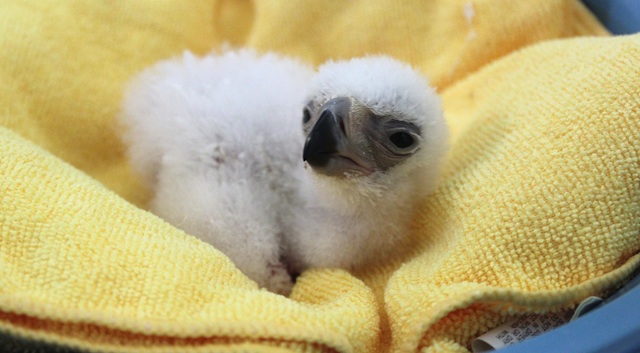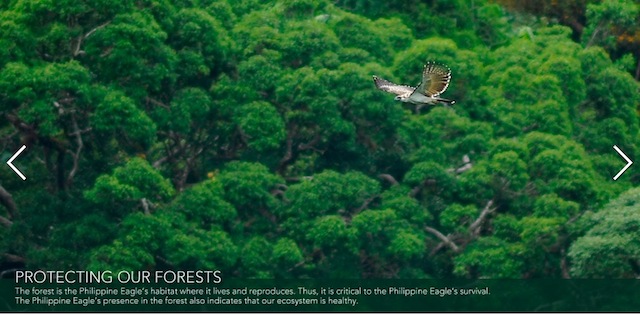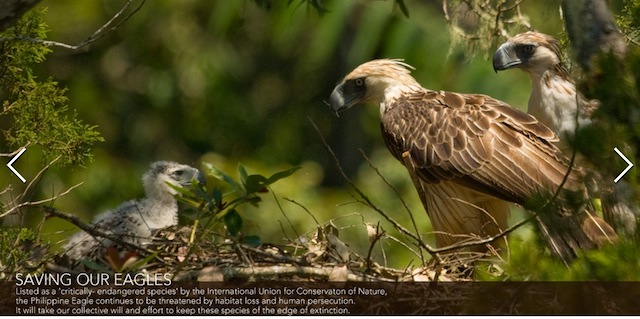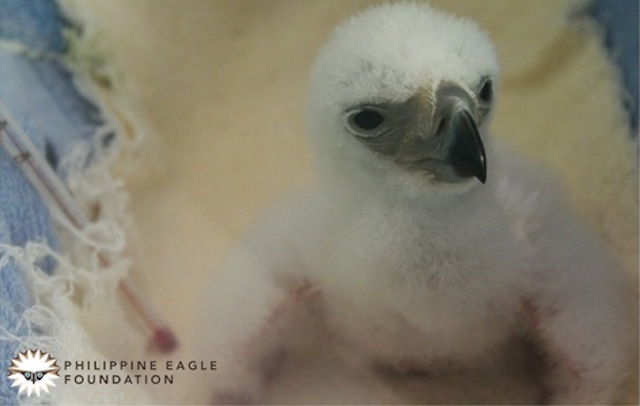DAVAO CITY (MindaNews / 13 December) – The Philippine Eagle Foundations’ Conservation Breeding Program in Malagos, Calinan has produced 26 eagles in 23 years – betweeen 1992 and 2015 — with Chick # 26 as the latest to have hatched from a natural pair last December 7.
“We are proud of our conservation breeding team for their perseverance at this very challenging task,” PEF Executive Director Dennis Salvador said, adding the recent hatching is “a big breakthrough for us and is the result of nearly five years of round robin pairing amongst our younger set of eagles at the Center.”
 Chick # 26 at 2 days old. The still unnamed Philippine Eagle hatched on December 7, 2015 at the Phlilippine Eagle Center in Malagos, Calinan, Davao City. Photo courtesy of the Phlippine Eagle Foundation
Chick # 26 at 2 days old. The still unnamed Philippine Eagle hatched on December 7, 2015 at the Phlilippine Eagle Center in Malagos, Calinan, Davao City. Photo courtesy of the Phlippine Eagle Foundation
A press release from the PEF said the hatching of Chick # 26, the first offspring of the eagle couple, will “rekindle hope for the species and usher a new generation of eagles to strengthen the captive gene pool and augment wild populations” and is “our gift to the Filipino people and the rest of the world this Christmas.
Described by the late aviator, Charles Lindbergh, as “the air’s noblest flier,” the Philippine Eagle (Pithecophaga Jefferyi), declared national bird in 1995, is listed as ‘Critically Endangered’ on the
International Union for Conservation of Nature (IUCN) Red List of Threatened Species.
The IUCN said the number of these majestic birds “has seen a steep decline, primarily due to habitat destruction,” noting that since the 1960s, vast tracts of tropical forest had been cleared for commercial development, cultivation and mining activities.
 Photo of the majestic Philippine Ealge from the website of the Philippine Eagle Foundation.
Photo of the majestic Philippine Ealge from the website of the Philippine Eagle Foundation.
The PEF estimates a population of “only 400 pairs remaining in the wild.”
The IUCN also observed that while a major captive breeding program is underway in Mindanao, “the key conservation need is to prevent any further forest loss within the range of this species.”
The PEF website says captive-bred eagles “will either be set for release in the wild where they can naturally augment their species’ population or kept in the Center for breeding purposes.”
MindaNews asked Salvador for a profile of the 26 and found, based on the records that he e-mailed, that:
- 19 of the 26 eagles conceived and hatched in captivity are alive and can be found in the Phlippine Eagle Center (PEC) in Malagos; seven died, five at the PEC, two in the wild, months after they were released
- 19 were conceived by a natural pair, seven by cooperative artificial insemination (CAI);
- 14 are male, seven female, and five unknown (four died before their sex could be determined; too early to determine for Chick # 26 as it is only a week old)
MindaNews also noted from the PEF data that eight pairs involving 14 eagles produced 26 offsprings, with eagle Junior paired with three eagles, through CAI.
The PEC hosts a total of 34 Philippine Eagles, 19 of them bred in captivity.
10 offsprings, 7 offsprings
Natural pair Kalayaan and Robinhood produced 10 offsprings between 1999 and 2011: seven of them alive and staying in the PEC: Pangarap and Kaibigan in 1999, Pagmamahal and Maginoo in 2000, Mindanao in 2001, Sambisig in 2002 and Enchanging Kagitingan in 2004. Three of their offsprings died: Macanudo and Chick #15 in 2003; and Chick # 24 in 2011.
 A family of Philippine Eagles in the wild. Photo from the website of the Philippine Eagle Foundation.
A family of Philippine Eagles in the wild. Photo from the website of the Philippine Eagle Foundation.
Natural pair LDI and Tsai produced seven offsprings between 2003 and 2010: five of them alive: Magilas in 2003, Dakila in 2005, Pin-pin in 2006, Bighani in 2007, and Imbulog in 2010. Three of their offsprings died: Chick # 17 in 2004 and Hineleban in 2006.
Hinelaban, then three years old, was released to the wild, inside the protected Mt. Kitangland Mountain Range on October 29, 2009, along with Kalabugao, a rescued and rehabilitated eagle.
Hinelaban was reported missing a month after its release. Tatit Quiblat, then PEF Information officer said an intensive search led to the recovery of the carcass of a male Philippine Eagle in Barangay Lupiagan in Bukidnon on January 15, 2010. It was believed to be Hinelaban’s.
According to PEF records, Imbulog’s status as of December 12, 2015, is “released / alive (PEC).”
First pair, first offspring
Eagles Diola and Junior were the first pair to have successfully produced the first Philippine Eagle conceived and hatched in captivity – Pag-asa (Hope) — on January 15, 1992. That same year, on October 25, Pag-asa’s sibling, Pagkakaisa hatched.
The 23-year old Pag-asa and Pagkakaisa have remained in their huge cages at the PEC.
On February 9 2013, the then 21-year old Pag-asa, paired with Zoom I through CAI, became a father to Mabuhay.
Kahayag and Junior produced three, also through CAI, two of them alive: Lourdes in 2000 and Geothermica in 2004. Its second offspring,
Kabayan, which hatched on November 23, 2002, was released into the forests of Mt. Apo, at the Philippine National Oil Company’s Geothermal Field in Barangay Ilomavis, Kidapwan City, on Earth Day, April 22, 2004.
Asia’s first
Kabayan was dubbed Asia’s first captive-bred bird released into the wild,
Kabayan, however, died from electrocution on January 8, 2005 when it perched on a high-voltage cable.
Named after the donor, then Vice President Noli “Kabayan” de Castro, Kabayan survived in the forest for 261 days, although ventured only near the release site. It was found dead about a kilometer from where it was freed.
On the day of Kabayan’s release on April 22, 2004, PEF’s Salvador gave the eagle a “50-50 chance at survival in the wild.”
Pitha and Junior produced one offspring, Scout Binay, in 2002. Binay remains at the PEC.
Dawan and Jag’s offspring, Mindanaw, died hours after it hatched on November 9, 1995.
 Chick # 26 at five days old. Photo courtesy of the Philippine Eagle Foundation
Chick # 26 at five days old. Photo courtesy of the Philippine Eagle Foundation
Salvador said the primary thrust of the conservation program is to “restore wild populations.”
“That involves protecting what remains of wild populations and their habitats, restoring forests to extend territories, enabling human communities to manage forests and protect wildlife themselves, and breeding for reintrodcution / release to augment wild populations,” he told MindaNews on Sunday. (Carolyn O. Arguillas / Mindanews)
